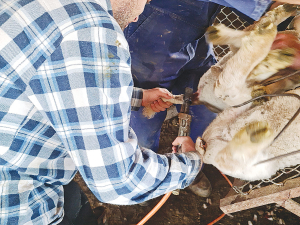Dairy power
OPINION: The good times felt across the dairy sector weren't lost at last week's Beef + Lamb NZ annual meeting.
 The docked tail must be no shorter than the distal end of the caudal fold - that's the end of the flaps of skin that attach the underside of the tail to the lamb's body.
The docked tail must be no shorter than the distal end of the caudal fold - that's the end of the flaps of skin that attach the underside of the tail to the lamb's body.
With docking - or tailing - underway in many areas, Beef+Lamb New Zealand is reminding farmers about the new tail length requirements.
Will Halliday, B+LNZ's senior advisor, animal welfare and biosecurity, says the length of the docked tail must be no shorter than the distal end of the caudal fold. That is the end of the flaps of skin that attach the underside of the tail to the lamb's body.
"This is the absolut minimum length under the new animal welfare regulations, which came into effect in May of this year."
Docking tails shorter than this can lead to an infringement fee of $500.
Halliday says a hot iron or rubber ring are the only methods that can be used to remove tails. He adds that using any other method can lead to a fine of $500.
"It is important farmers ensure their docking or tailing gangs are aware of what is required under the new regulations and the people removing the tails are adhering to that minimum length."
Only lambs under six months can be docked by a farmer or staff - any lambs older than six months must be done by a vet.
Docking a lamb over six months old is an offence with a fine on conviction of up to $3,000.
Last month's Agritechnica event led to a wide group of manufacturers celebrating successes when the 2026 Tractor of the Year Competition winners, selected by a panel of European journalists, were announced in Hanover Germany.
According to the latest Federated Farmers banking survey, farmers are more satisfied with their bank and less under pressure, however, the sector is well short of confidence levels seen last decade.
Farmer confidence has taken a slight dip according to the final Rabobank rural confidence survey for the year.
Former Agriculture Minister and Otaki farmer Nathan Guy has been appointed New Zealand’s Special Agricultural Trade Envoy (SATE).
Alliance Group has commissioned a new heat pump system at its Mataura processing plant in Southland.
Fonterra has slashed another 50c off its milk price forecast as global milk flows shows no sign of easing.

OPINION: The release of the Natural Environment Bill and Planning Bill to replace the Resource Management Act is a red-letter day…
OPINION: Federated Farmers has launched a new campaign, swapping ‘The Twelve Days of Christmas’ for ‘The Twelve Pests of Christmas’ to…